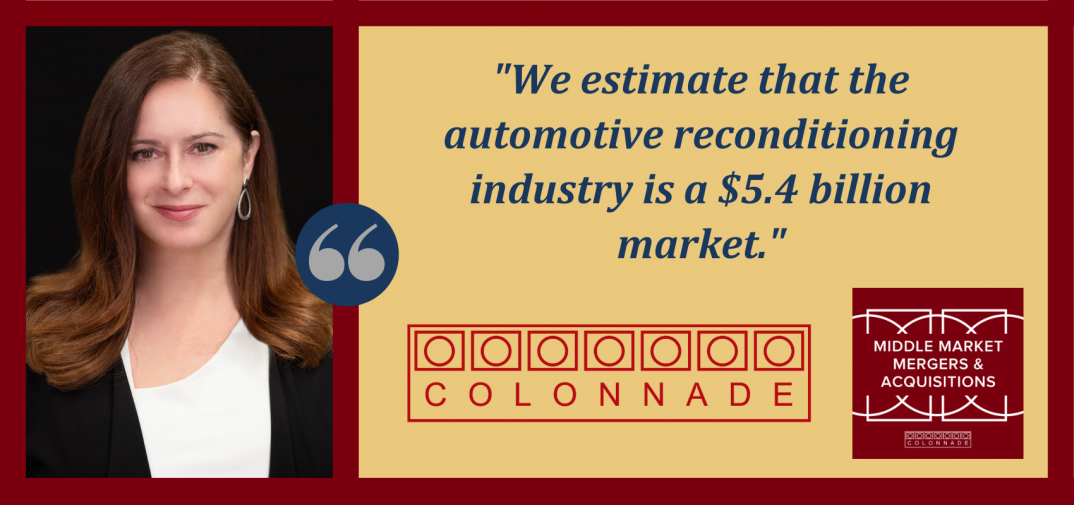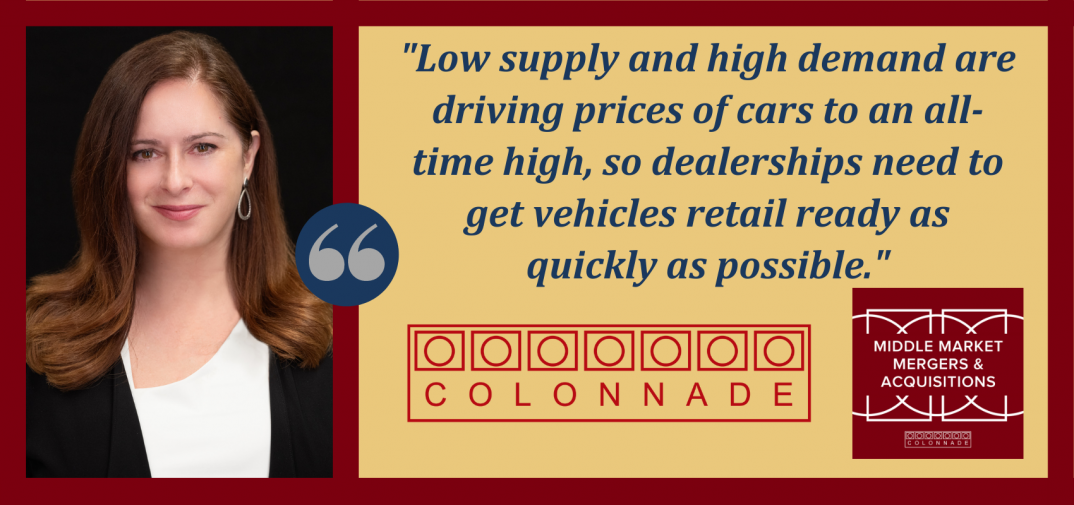This episode continues our series of “industry spotlights,” focusing on specific trends and opportunities in middle-market M&A transactions. Previous episodes include Insurance Premium Finance, Vehicle Service Contract Administrators, and Home Warranty.

This episode focuses on the automotive reconditioning industry, a $5.4 billion industry that is highly fragmented and ripe for consolidation.
Colonnade has extensive transaction experience in the automotive services industry and has been the sell side or buy side M&A advisor on many of the automotive services industry transactions that have taken place over the last decade. Colonnade has insider-level mastery of the drivers of valuation, competitive positioning, business trends, relevant metrics, and the right buyer universe, enabling us to provide superior deal execution to our clients.
Colonnade recently published a white paper on the automotive reconditioning industry. The white paper is available here.
In this episode, we answer the following questions:
- What is automotive reconditioning?
- Why do automotive dealerships outsource reconditioning?
- What is the industry size, and who are the largest participants in the industry?
- What are the value drivers for automotive reconditioning companies?
- What are the M&A trends in the automotive reconditioning industry?
What is automotive reconditioning? (02:10)
Gina: Automotive reconditioning is the process of making a newly acquired vehicle retail-ready. Dealerships get cars in a couple of ways. On the new side, they get it directly from the OEMs, and on the used side, they may be buying it from auctions or taking vehicles as a trade-in. Used vehicles need to be reconditioned to be car lot ready.
Do dealerships have an in-house reconditioning department? (04:17)
Gina: The majority of dealerships outsource reconditioning.
What is the size of the automotive reconditioning industry, and who are the industry participants? (05:01)
Gina: We estimate that the automotive reconditioning industry is a $5.4 billion market. It is comprised of mainly single technician entrepreneurs, a technician who is skilled in a specific trade. When a dealership outsources reconditioning, they are probably outsourcing it to three to five reconditioning technicians that are independent contractors.

What types of dealerships typically outsource automotive reconditioning versus having it in-house? (06:25)
Gina: The largest dealerships are the most likely to outsource because they realize how inefficient it is to have highly paid employees reconditioning cars. They could use that time doing much more valuable service lane work. Independent dealerships and smaller dealerships tend to have automotive reconditioning done in-house.
How many companies are in the automotive reconditioning industry? (07:50)
Gina: We don’t really see many companies of scale. Based on the number of dealerships out there, we estimated as many as 40,000 independent technicians nationwide doing this type of work.
Why do dealerships outsource automotive reconditioning? (09:57)
Gina: Skilled technicians are expensive and in high demand at dealerships. Outsourcing automotive reconditioning helps to keep up the profitability of the dealership.
Why do dealerships need to make vehicles retail ready as quickly as possible? (10:30)
Gina: New and used vehicle supplies are low, and demand is high. Low supply and high demand are driving prices of cars to an all-time high, so dealerships need to get vehicles retail ready as quickly as possible.

How do dealerships manage relationships with multiple outsourced automotive reconditioning vendors? (13:02)
Gina: It is a lot of process management, and there is some software to manage the process, but still, managing five different vendors is inefficient, especially if the dealers do not control their daily activity because they are independent.
Who are the largest participants in the automotive reconditioning industry? (14:05)
Gina: The largest in the industry is Dent Wizard. Some companies, such as Streamline Recon, are located in large metropolitan markets, and they may have some scale. But, aside from these companies, there are not many companies of scale. This industry is very fragmented.

What systems or processes do automotive reconditioning companies need to scale up? (16:16)
Gina: There are a couple of reconditioning workflow management software available, which seem to be critical to any dealership technician relationships that they want to run efficiently. There is room for the adoption of robust workflow management software in the reconditioning process.
Does automotive reconditioning include fixing a vehicle’s mechanical issues? (18:00)
Gina: The mechanical part, making sure the car runs without banging noises and that it starts and stops, is all done before it gets to the reconditioning center. Automotive reconditioning is all about appearance.

How does the collision center industry compare with the automotive reconditioning sector? (19:10)
Gina: The collision industry is a very different market. The work is largely being paid for by insurance companies in the collision industry and has nothing to do with dealerships. So, you do not see collision centers doing reconditioning work very often. They are very separate businesses.
What are the value drivers for automotive reconditioning companies? (20:38)
Gina: Value drivers include size, number of employees, scale, and diversification of revenue. Also, process management is an important component.
What are the M&A trends in the automotive reconditioning industry? (22:34)
Gina: We will see quite a bit of M&A activity in this space over the next decade. It is a profitable industry that is important to dealerships. Dealerships outsource automotive reconditioning to several vendors, which is inefficient in terms of process management. Automotive reconditioning companies that can do it all for dealerships will be the winners.






